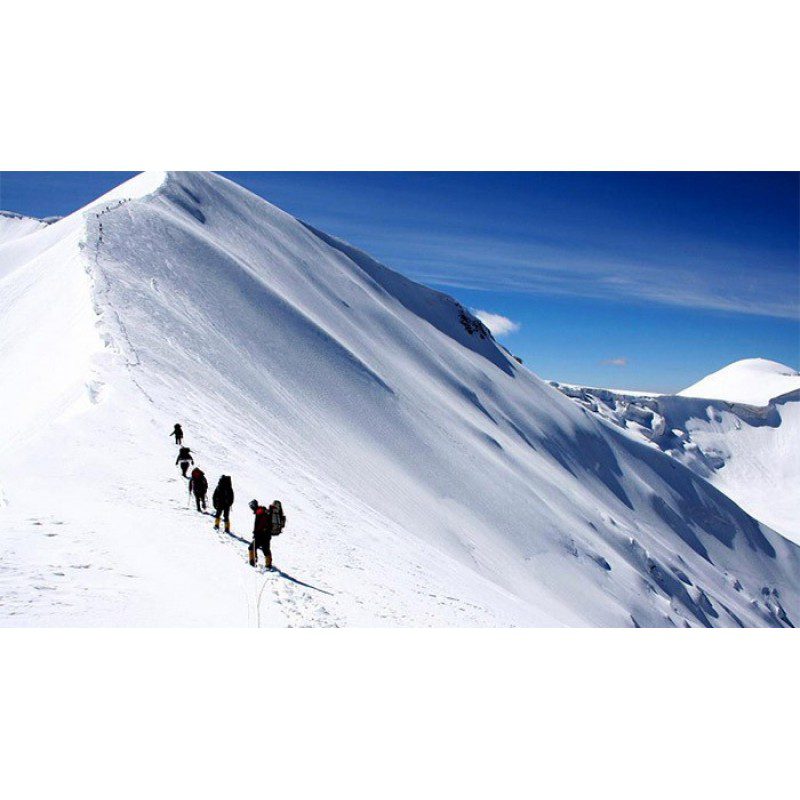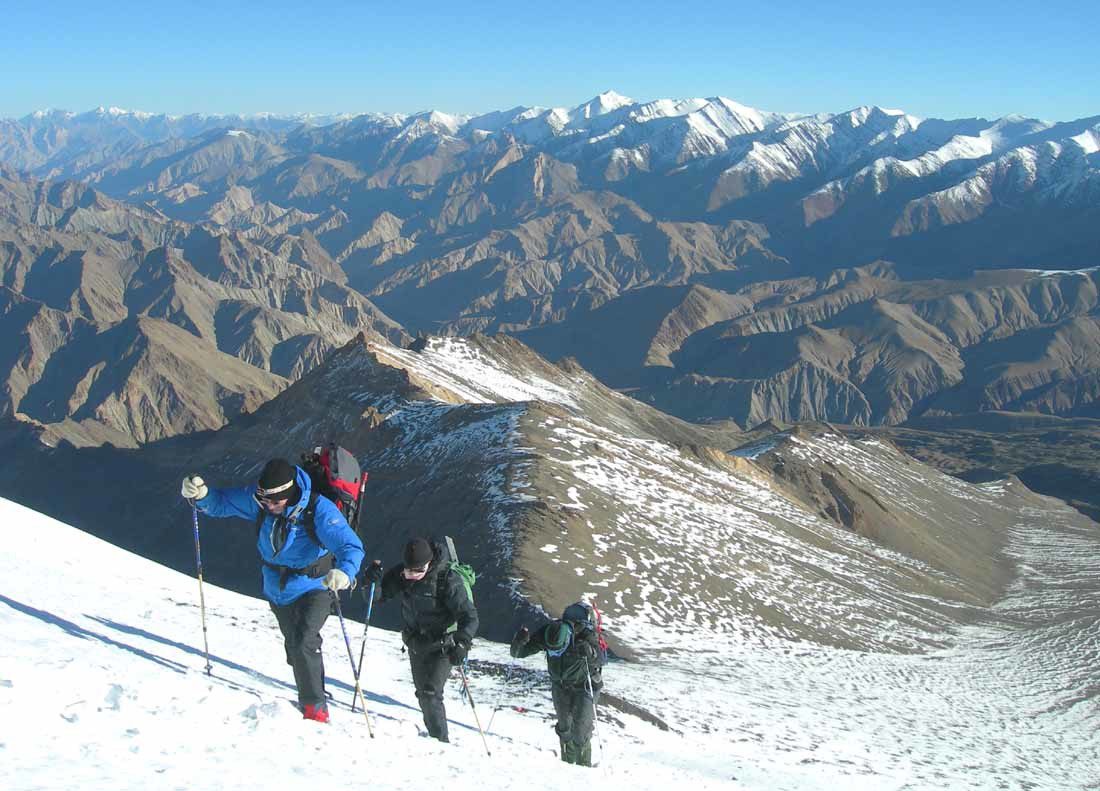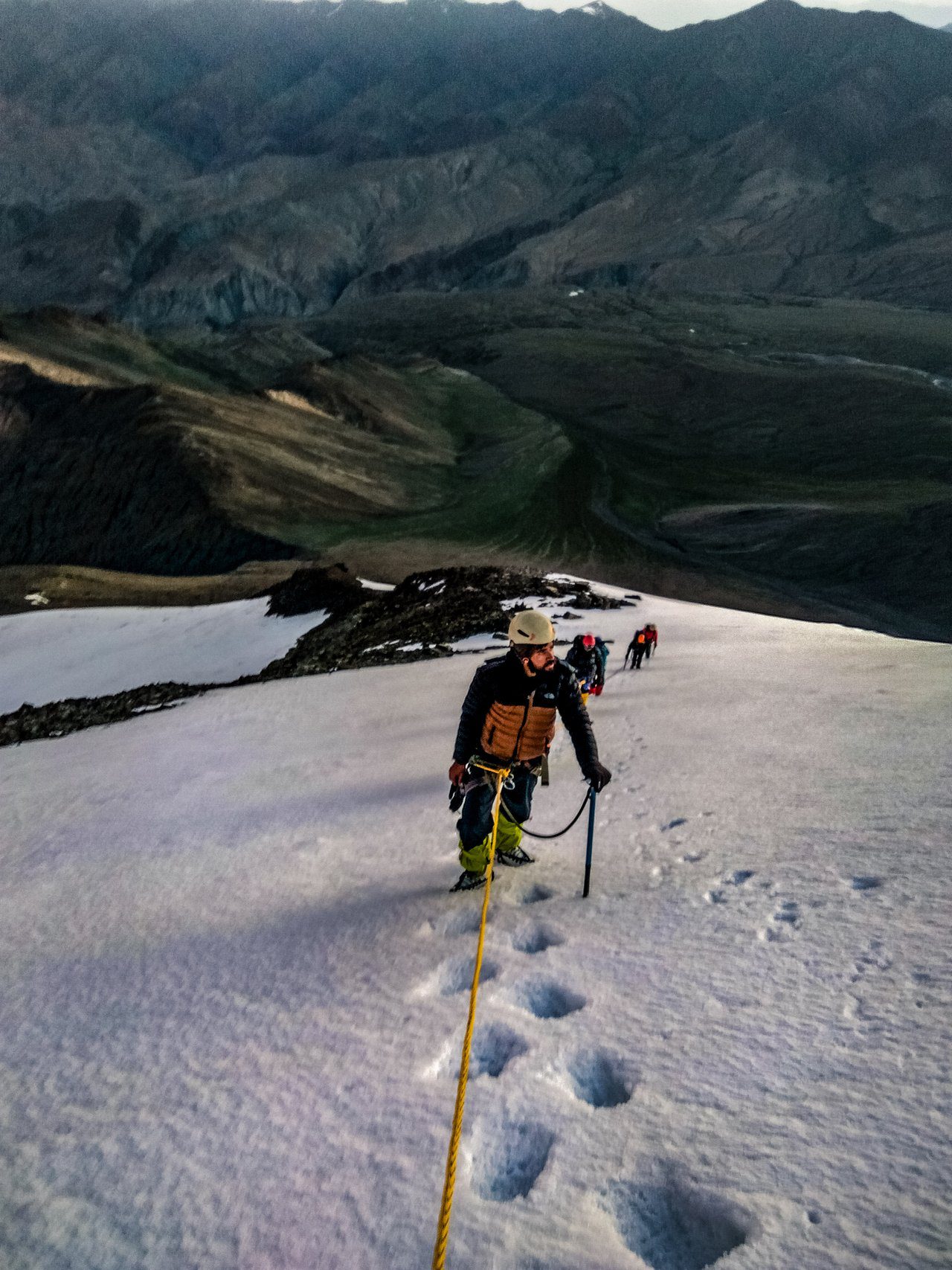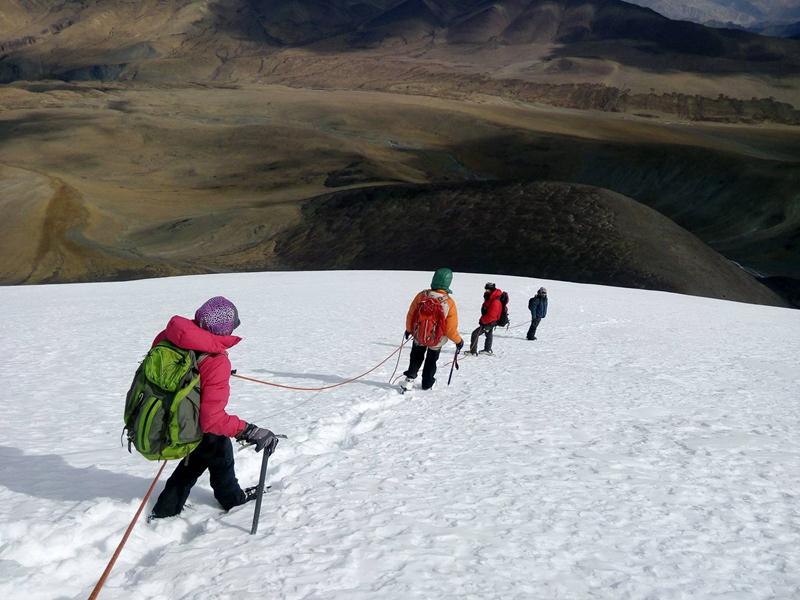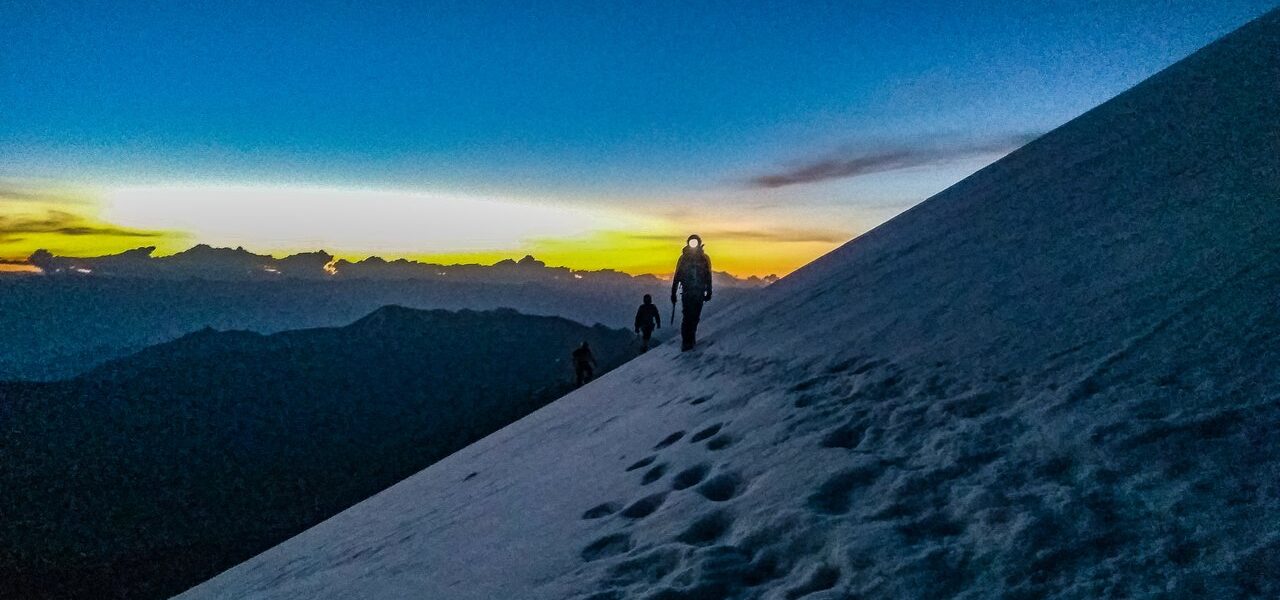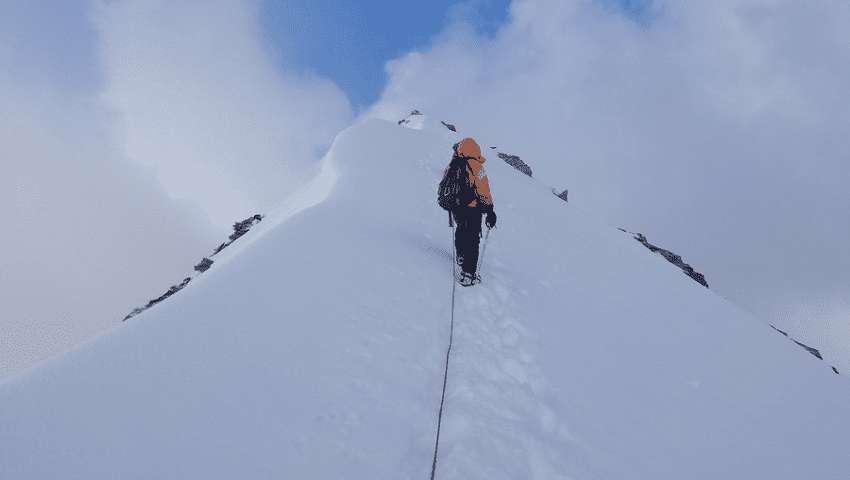The rugged beauty of Ladakh has drawn adventurers from all corners of the globe, and two of the most sought-after treks in this remote region are the Chadar Trek and Kang Yatse trek. Each offers a unique and challenging experience, but which one is right for you? In this comprehensive guide, we’ll explore the differences between these two epic treks, helping you decide whether to walk on a frozen river or climb a towering Himalayan peak.
Introduction to Chadar Trek and Kang Yatse
Ladakh’s isolation and breathtaking landscapes make it an adventure traveler’s paradise, and trekking is one of the best ways to immerse yourself in its stark, otherworldly beauty. The Chadar Trek is a frozen river trek along the Zanskar River, only possible in winter when the river turns into a thick sheet of ice. In contrast, the Kang Yatse Trek offers a high-altitude adventure, including a summit of the 6,400-meter Kang Yatse peak, located in the Markha Valley.
While both treks promise unforgettable experiences, they differ significantly in terms of difficulty, landscape, and the kind of adventure they provide. Let’s dive into the details to help you choose.

Key Differences Between Chadar Trek and Kang Yatse
Trek Type: Frozen River vs. Peak Climbing
The Chadar Trek is a unique experience, as you walk across a frozen river in sub-zero temperatures. The river serves as your path, and the terrain is flat but challenging due to the ice and cold. It’s an adventure through a frozen wonderland, where every step needs to be carefully placed.
On the other hand, the Kang Yatse Trek is a peak climbing expedition. Trekkers venture through lush valleys, traverse high mountain passes, and climb the towering Kang Yatse peak. This trek involves altitude gain, technical sections, and demanding terrain, making it suitable for trekkers with some mountaineering experience.
“I did the Chadar Trek in January and walking on a frozen river was unlike anything I had ever experienced! It was challenging but so worth it. The frozen waterfalls and snow-covered landscapes were surreal.” — John D., Software Engineer, USA
Altitude and Difficulty Comparison
The Chadar Trek is not technically difficult, but the extreme cold and potential for altitude sickness make it a serious challenge. The trek occurs at altitudes of around 11,000 feet (3,500 meters), with temperatures dipping as low as -30°C (-22°F). Trekkers must be prepared for these harsh conditions.
In contrast, the Kang Yatse trek climbs much higher, reaching an altitude of over 6,400 meters (21,000 feet) at the summit. The higher altitude and steeper terrain make this trek more physically demanding and technical. Experience in high-altitude trekking is highly recommended.
“Climbing Kang Yatse was the hardest trek I’ve done, but also the most rewarding. The altitude was a challenge, but the views from the summit were breathtaking, overlooking the entire Ladakh range.” — Maria L., Travel Blogger, Spain
| Trek |
Maximum Altitude |
Difficulty |
| Chadar Trek |
11,000 ft (3,500 meters) |
Moderate, Extreme Cold |
| Kang Yatse |
21,000 ft (6,400 meters) |
Strenuous, Technical Climbing |
Duration and Itinerary
The Chadar Trek is generally completed over 8-9 days, with most days involving 5-6 hours of trekking on the frozen river. The itinerary includes camping in caves and alongside the river, as well as interactions with the local Zanskari people.
The Kang Yatse trek typically lasts 10-12 days, with an additional summit attempt that can extend the trek to 14 days. This trek takes you through the Markha Valley, with its green meadows, remote villages, and towering peaks, before the demanding climb to the summit of Kang Yatse.

“The Chadar Trek was a shorter trek compared to others I’ve done, but the extreme conditions made it feel like a much bigger challenge. The interaction with the local Zanskari people was one of the highlights.” — Rahul S., Entrepreneur, India
When Is the Best Time for Each Trek?
Best Time to Experience the Chadar Trek
The Chadar Trek is only accessible during the winter months of January and February, when the Zanskar River is completely frozen. This period offers the most stable ice conditions, but it’s also when the temperatures are at their coldest. Be prepared for freezing weather, and ensure that you have the proper gear to withstand the elements.
Best Time to Attempt Kang Yatse
Kang Yatse is a summer trek, best attempted from June to September. During this time, the snow has melted enough to allow for trekking, but temperatures at higher altitudes can still be quite cold. The summer months also offer clearer skies, providing the best chance for successful summit attempts.
“We did Kang Yatse in July, and the weather was perfect for trekking—sunny days and cool nights. The trek through the Markha Valley was stunning, with lush greenery and snow-capped peaks in the background.” — Sophie M., Photographer, France
Adventure Levels: Which Trek Is More Challenging?
Physical Fitness and Preparation for Chadar Trek
Although the Chadar Trek is not technically difficult, it requires excellent physical fitness due to the cold, long walking days, and the risk of altitude sickness. You’ll be walking on ice for hours each day, and the extreme cold will test your endurance. Preparation should include cardiovascular training and cold-weather acclimatization.
Climbing Challenges of Kang Yatse
Kang Yatse, however, is more physically demanding due to the altitude and the need for basic mountaineering skills. The summit climb requires the use of ropes, ice axes, and crampons. If you’re looking for a serious adventure and have some climbing experience, Kang Yatse will offer the challenge you’re after.

“I had done several treks before, but Kang Yatse pushed my limits. Reaching the summit was tough, but the feeling of standing at the top of the world made it all worthwhile.” — Alex H., Investment Banker, UK
Unique Experiences on Chadar Trek and Kang Yatse
Highlights of the Chadar Trek
The Chadar Trek is all about walking on ice in a frozen, remote wilderness. You’ll pass frozen waterfalls, ice cliffs, and snow-covered mountains. It’s a stark, monochromatic landscape, but its beauty lies in its simplicity. You’ll also interact with the local Zanskari people, who have lived in these harsh conditions for centuries.
Stunning Views from the Kang Yatse Summit
The highlight of Kang Yatse is the view from the summit. From the top, you’ll have panoramic views of the Ladakh Range, the Zanskar Range, and even Karakoram on a clear day. The trek also passes through some of Ladakh’s most scenic valleys, offering an incredible contrast between lush greenery and stark mountain peaks.
Cost Comparison: Chadar Trek vs. Kang Yatse
Chadar Trek Cost Breakdown
The Chadar Trek is relatively affordable due to its shorter duration and lack of technical requirements. Expect to pay between ₹20,000–₹35,000 INR ($250-$450 USD) for a guided trek, including food, accommodation, and permits.

Cost of Trekking Kang Yatse
The Kang Yatse trek is more expensive due to its longer duration and the need for specialized climbing gear and guides. Costs can range from ₹40,000–₹70,000 INR ($500-$900 USD), depending on the number of days and the level of service provided.
Which Trek Is Best for You?
Choosing Chadar Trek
If you’re a beginner trekker or someone looking for a once-in-a-lifetime winter adventure in a surreal landscape, the Chadar Trek is perfect. It’s not technically difficult, but the extreme cold will challenge your endurance and make you feel like you’ve ventured into a frozen wilderness.
Choosing Kang Yatse
For seasoned trekkers looking to push their limits with a high-altitude peak climb, Kang Yatse offers the adventure of a lifetime. The combination of scenic valley trekking and a challenging summit attempt makes it an unforgettable experience.
What to Pack for Chadar Trek vs. Kang Yatse
Essential Gear for Chadar Trek
- Waterproof trekking boots
- Layered clothing for sub-zero temperatures
- Sleeping bag rated for -30°C
- Crampons for walking on ice
- Hand and foot warmers
Packing for the Kang Yatse Expedition
- High-quality trekking boots with ankle support
- Mountaineering gear (ice axe, crampons, ropes)
- Insulated clothing for high-altitude conditions
- Sunscreen and sunglasses (UV protection is critical at high altitudes)
- Energy bars and snacks for the long trek

FAQs About Chadar Trek and Kang Yatse
Is the Chadar Trek Safe for Beginners?
The Chadar Trek can be safe for beginners who are physically fit and prepared for the cold. However, it is important to acclimatize and ensure you have the proper gear for sub-zero temperatures.
Do I Need Permits for Kang Yatse?
Yes, you need permits for trekking in the Markha Valley and for summiting Kang Yatse. These can typically be arranged by your trekking company.
How Long Does It Take to Complete Chadar Trek?
The Chadar Trek takes about 8-9 days to complete, depending on the route and weather conditions.
Is Kang Yatse More Difficult Than Stok Kangri?
Yes, Kang Yatse is generally considered more difficult than Stok Kangri due to its technical sections and higher altitude.
Which Trek Is Best for Beginners?
Chadar Trek is better suited for beginners, while Kang Yatse is more challenging and recommended for experienced trekkers.
What Is the Maximum Altitude for Chadar Trek and Kang Yatse?
Chadar Trek reaches about 11,000 feet (3,500 meters), while Kang Yatse summit climbs to 21,000 feet (6,400 meters).
Chadar Trek vs. Kang Yatse
Chadar Trek vs. Kang Yatse | The journey through Ladakh mirrors the very essence of unraveling unknown horizons, as its dramatic landscapes and unique cultural identity awaken the deepest sense of wonder and exploration. Chadar Trek vs. Kang Yatsedelves into this realm where inner peace intertwines with the wild, untouched beauty of Ladakh. From the snow-capped peaks to the serene monasteries, every step in Ladakh is a step toward self-discovery. The mountains, ancient paths, and unspoken mysteries stretch before travelers, offering a meditative experience where each encounter feels both effortless and transformative. Whether it’s trekking across remote valleys or sitting quietly beside a sacred lake, Ladakh invites those who seek a deeper connection to the natural and spiritual world.

The Chadar Trek vs. Kang Yatse’s Chadar Trek vs. Kang Yatse
The monasteries of Ladakh stand as living monuments to the region’s profound spiritual heritage. With origins dating back over a thousand years, these ancient structures are both places of worship and repositories of art, culture, and wisdom. Hemis Monastery, one of the largest in Ladakh, is renowned for its annual festival, featuring colorful mask dances performed by monks. The history of these monasteries reflects Ladakh’s role as a crossroads between India, Tibet, and Central Asia, where religious and cultural influences have intertwined over the centuries.
The Tibetan Buddhist influence is especially evident in the architecture and daily life of the monks. Prayer wheels, intricate murals, and the soft hum of chants fill the air as visitors explore the monastery grounds. Each monastery, from the remote Lamayuru to the awe-inspiring Thiksey, offers a window into the spiritual heart of Ladakh. These centers of meditation, learning, and community life continue to thrive, preserving traditions that have shaped Ladakh for generations.
Why Visit Ladakh for Chadar Trek vs. Kang Yatse?
Ladakh is a destination that transcends mere travel. It offers a journey that touches both the outer and inner landscapes, making it a perfect setting for those who seek to unravel their own unknown horizons. The region’s breathtaking scenery—from towering mountain ranges to hidden valleys—provides not just an escape but a space for contemplation and growth. Ladakh’s culture, deeply rooted in Buddhist practices, invites visitors to reflect on their own lives and the world around them.
Ladakh’s people, known for their warmth and hospitality, add to the richness of the experience. Villages like Sumda Chun and the legendary Nubra Valley introduce travelers to a way of life that is intricately connected to nature and spirituality. Staying in local homestays allows for immersive experiences where one can learn about traditional Ladakhi customs, share meals made from local produce, and participate in community rituals.

Beyond its natural beauty, Ladakh offers a unique opportunity to explore oneself. The vastness of the region’s plateaus and the clarity of its skies seem to mirror the vastness of the human spirit. Whether it’s standing atop a mountain pass at 18,000 feet or meditating in a centuries-old monastery, Ladakh helps unravel the unknown horizons within each traveler.
Finding the Best Chadar Trek vs. Kang Yatse in Ladakh
Finding the best places in Ladakh to experience “Chadar Trek vs. Kang Yatse” involves venturing off the beaten path. Ladakh’s lesser-known treks, such as those leading to secluded monasteries or high-altitude lakes, offer unparalleled opportunities for solitude and reflection. The Markha Valley trek, for instance, takes travelers through verdant valleys, ancient villages, and high-altitude passes, allowing for both physical and spiritual exploration.
Ladakh’s iconic lakes, including Pangong Tso and Tso Moriri, are ideal spots for quiet contemplation. Their still waters reflect the sky, creating a mesmerizing landscape that feels timeless and infinite. Sitting beside these lakes, especially at dawn or dusk, brings an overwhelming sense of peace and connection with nature.

For those interested in Ladakh’s spiritual heritage, exploring monasteries such as Alchi, Phyang, or Diskit can be a transformative experience. These sites are not just places of worship but also centers of art, philosophy, and wisdom. Visiting these monasteries, with their ancient murals and intricate statues, offers insight into Ladakh’s rich cultural tapestry.
Ladakh’s Atmosphere and Chadar Trek vs. Kang Yatse
Ladakh’s atmosphere is unlike any other place on Earth. The stark contrasts between the rugged mountains and the serene, tranquil monasteries create an environment that feels both raw and sacred. The traditional decor in Ladakhi homes and religious sites reflects this balance, with mud-brick houses adorned with prayer flags and colorful thangkas (Buddhist paintings) that add warmth and spiritual meaning to the space.

The interiors of Ladakhi homes, often simple and functional, are filled with symbols of devotion. Small shrines dedicated to Buddhist deities are common, and the air is often fragrant with incense. The use of earthy materials, like stone and wood, along with brightly colored textiles, creates an inviting and peaceful space, perfect for relaxation and reflection.
Traditional Ladakhi Cuisine
Traditional Ladakhi cuisine is an integral part of the region’s identity, offering a unique blend of flavors that reflect its harsh climate and remote location. Hearty, warming dishes such as thukpa (noodle soup) and momos (dumplings) provide the sustenance needed to endure Ladakh’s cold temperatures. Skyu, a thick stew made with root vegetables and barley, is another staple of the Ladakhi diet, designed to nourish both body and spirit.

Drinks like butter tea, made with yak butter and salt, are a must-try for anyone visiting Ladakh. This rich, savory drink is not only warming but also hydrating, making it essential for those venturing into the high-altitude regions of Ladakh. Chang, a local barley beer, is often enjoyed during festivals and community gatherings, adding a sense of joy and camaraderie to any occasion.
Live Cultural Chadar Trek vs. Kang Yatse in Ladakh
Ladakh is home to a vibrant cultural scene, with festivals and live performances held throughout the year. The Hemis Festival, which celebrates the birth of Guru Padmasambhava, is one of the largest and most famous events in the region. Monks dressed in elaborate costumes perform cham dances, which depict the triumph of good over evil. The energy of the festival, with its bright colors, rhythmic music, and elaborate rituals, draws visitors from around the world.
Other local festivals, such as the Losar (New Year) and Ladakh Festival, provide visitors with the chance to witness traditional dance, music, and crafts that have been passed down through generations. These events are more than just entertainment; they are a celebration of Ladakh’s rich cultural heritage and its deep connection to the spiritual world.
Trekking and Outdoor Activities Chadar Trek vs. Kang Yatse
Ladakh is a trekker’s paradise, offering some of the most stunning and challenging routes in the world. From the famous Chadar Trek vs. Kang Yatse, which follows the frozen Zanskar River, to lesser-known routes like the Sham Valley or Nubra Valley treks, Ladakh’s landscape offers endless possibilities for adventure and discovery. The high-altitude passes, such as Khardung La and Chang La, offer breathtaking views of snow-capped peaks and sprawling valleys.

Wildlife enthusiasts will also find Chadar Trek vs. Kang Yatse to be a haven for rare species such as the snow leopard, Himalayan blue sheep, and the Tibetan wild ass. Winter expeditions to spot the elusive snow leopard in the Hemis National Park are gaining popularity among wildlife photographers and conservationists alike.
The Importance of Preserving Ladakh’s Chadar Trek vs. Kang Yatse
Ladakh’s rich cultural and environmental Chadar Trek vs. Kang Yatse is under increasing threat from climate change and mass tourism. Preserving this unique region requires careful attention to sustainable tourism practices. Choosing eco-friendly accommodations, supporting local businesses, and participating in community-led conservation efforts are just a few ways that visitors can contribute to the preservation of Ladakh’s natural and cultural heritage.
Ladakh’s people have a long history of living in harmony with their environment, practicing sustainable agriculture, and maintaining a deep spiritual connection to the land. Visitors are encouraged to follow the same principles, leaving no trace and respecting the fragile ecosystems that make Ladakh so special.
Etiquette and Tips for Visiting Chadar Trek vs. Kang Yatse
Before visiting Ladakh, it’s essential to understand and respect the region’s customs and traditions. As a deeply spiritual place, Ladakh requires visitors to dress modestly, especially when visiting monasteries or attending religious ceremonies. Always ask for permission before taking photographs inside monasteries or of local people.
Medical Chadar Trek vs. Kang Yatse
Spa trail Chadar Trek vs. Kang Yatse
Chadar Trek vs. Kang Yatse

When Chadar Trek vs. Kang Yatse, remember to stay on designated paths to avoid damaging fragile ecosystems. Tipping is appreciated but not expected in most settings, and it’s important to carry cash, as many remote areas do not accept credit cards. Lastly, be mindful of altitude sickness and take the necessary precautions when traveling to higher elevations.
Conclusion: Enjoying Chadar Trek vs. Kang Yatse in Ladakh
Ladakh is a place where the physical and spiritual worlds converge, offering travelers a journey unlike any other. Whether you’re trekking across high-altitude deserts, exploring ancient monasteries, or simply sitting in quiet reflection by a mountain lake, Ladakh invites you to unravel your own unknown horizons. By respecting the region’s traditions and practicing sustainable tourism, you help ensure that Ladakh’s beauty and cultural richness will be preserved for future generations to explore and enjoy.
